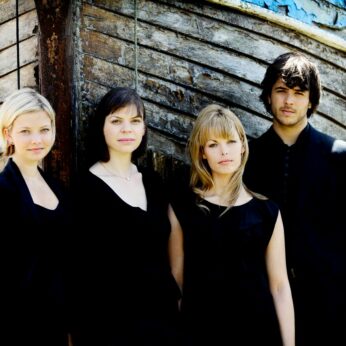Composer: Ludwig van Beethoven (b. 1770 - d. 1827)
Performance date: 28/06/2019
Venue: Bantry Library
Duration: 00:29:18
Recording Engineer: Ciaran Cullen, RTÉ
Instrumentation: 2vn, va, vc
Instrumentation Category:String Quartet
Artists:
Chiaroscuro Quartet (Alina Ibragimova, Pablo Hernán Benedí [violins], Emilie Hörnlund [viola], Claire Thirion [cello]) -
[quartet]

Ludwig van Beethoven [1770-1827]
String Quartet in F major Op.18/1 [1798/1800]
1. Allegro con brio
2. Adagio affetuoso ed appassionato
3. Scherzo: Allegro molto
4. Allegro
Take this quartet as a small memorial of our friendship and whenever you play it recall the days we spent together and the sincere affection felt for you then…
Inscription by Beethoven to Karl Amenda on first violin part of Op.18/1
Beethoven began his first set of quartets in 1798 on foot of a commission from Prince Lobkowitz. The Prince had established a private orchestra at his Palace in 1796 and soon became one of Beethoven’s most enthusiastic admirers and patrons. Beethoven was paid in two instalments, half after completion of the first three in October 1799 and the balance a year later when the whole set was complete after extensive revisions to the first three – very similar to how commissioning of new work is handled nowadays. At the very same time the Prince commissioned Haydn to write a new set, but the ageing composer only completed two and a half quartets that we know as Op.77 and Op.103. At this time Haydn had been Beethoven’s teacher, but the baton had now been passed on.
The first movement is dominated by the little turn-like figure that opens the work, played in unison by all four instruments one octave apart. No fewer than sixteen pages of his sketchbooks are taken up with revisions to this theme which has been described as beautifully incisive, harmonically clinched, rhythmically useful for every thematic, developmental or accompanying purpose. The turn is played three times and then rounded off by a three-bar phrase. This is the first subject and its rhythm also pervades the transition passage. The second subject is a gentle curving theme with repeated notes, but it is quickly ousted by a re-appearance of the opening motif. The development is built exclusively on it, save for a brilliant scale passage that leads to the recapitulation, and so is the coda
The magnificent elegiac slow movement has a principal theme of tragic intensity and although Beethoven had reservations about programme music, we know that he had some kind of programme in mind when composing this movement. He played it for Amenda and asked him what he thought it suggested. Amenda said that It pictured for me the parting of two lovers. Good! remarked Beethoven: I thought of the scene in the burial vault in Romeo and Juliet. Could this also refer to Beethoven’s love for Giulietta Guicciardi, a fascinating girl aged seventeen who was one of his pupils? He dedicated his Moonlight Sonata to her and described her in a letter as a dear charming girl who loves me and whom I love, but she was a Countess, and after flirting with Beethoven she married a man of her own social class. The slow movement of the Quartet spaciously expresses a sense of tragedy that is beyond any of his predecessors except Gluck. The funereal mood is created by the regular reiteration of quavers on the lower instruments beneath the tender, sorrowful melody that rises on the violin and, later in the movement, on the cello. In a sketch for the closing bars Beethoven wrote the last breath.
The Scherzo is built in two repeated sections upon a light rising theme that is underlined with trills and staccato notes. In the Trio the accents are reminiscent of folk dancing. The heavy reiterated calls summon music of a strength and firmness that dispels the shadow cast by the slow movement. The final movement is in sonata-rondo form and is distinguished by playful triplets. It is the most informal movement of the four, yet the contrast between the quicksilver first subject and other more cantabile, singing, elements, creates a spaciousness that enables it to balance the first movement.
– Sarah M. Burn
Copyright © 2025 West Cork Music. All rights reserved.
Designed and developed by Matrix Internet